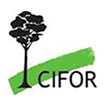
Too often, the debate about forests in policy circles is reduced to two options: deforestation or total protection, according to Francis E. Putz.
Putz and Claudia Romero, both researchers at the University of Florida, chose to take a different approach.
“We looked at a large area of forests that falls outside these two existing options,” said Putz. “We are trying to inform decisions about forests that aren’t in protected areas.”
In a recently published study by the Center for International Forestry Research (CIFOR), Putz and Romero examined the different forest management and conservation options that exist today for the world’s tropical forests.
It is a subject that can be contentious.
“It’s a hard story to tell because we are not promoting logging,” said Putz. “We are saying that there are acceptable and unacceptable forest management methods and if you want to achieve the latter, there are several issues that need to be considered.”
Practical thinking
Many researchers, said Putz, document the impacts on tropical forestry and conclude that there is no other option for forest protection besides converting them into parks.
“I’d like to convert the remaining forests in the tropics into one protected area for future generations to enjoy, but that’s unfortunately not going to happen,“ said Putz.
“That’s why we are trying to find a solution for land that falls between complete protection and conversion. It’s still going to be forest, but it’s going to be managed forest, not primary forest.”
Putz contends that protection is not a viable option in many areas, especially those close to roads and well-settled areas.
“All land is not equivalent in its productive capacity or in its ecological importance, so we need to plan at landscape scales,” said Putz.
Impacts are of course to be expected when forests are managed, but the sorts and extents of those impacts vary with whether the area is being managed responsibly or not.
“But where alternative land uses such as oil palm plantations are very lucrative, we need to do everything we can to make natural forest management financially attractive and sustainable in terms of yield and biodiversity. If we don’t, the opportunity costs of maintaining forests will simply be too high.”
Good forest management is possible at all scales, from large industrial concessions to small community-owned forest
So what constitutes good forest management?
“Most people will agree that there are forest management practices that clearly minimize downstream damage, avoid biodiversity losses, and keep workers safe. But after instituting those basic improvements, what constitutes responsible forest management varies with factors that range in scales from individual trees to entire landscapes,“ said Putz.
“There are some principles of good forestry that span the gamut from high-intensity plantations to the lightest selective harvests, but after that, the details differ.”
Contestations
Adding to the complexity of the issues related to tropical forestry are the different stakeholder groups involved.
“We need to understand that tropical forests are located in contested territories where claims by indigenous communities overlap with those of mining companies and other industries,” said Romero. “Governments need to juggle all these competing claims regarding tropical forests.”
“We found that there are a lot of opportunities to manage forests for timber and other products that need to be considered to help manage competing needs of different stakeholders.”
“Forest managers make decisions based on criteria that include market pressures and global demand. Policy makers need to be more sensitive to those signals in order to tailor appropriate policies for responsible forest management,” Romero added.
“Good forest management is possible at all scales, from large industrial concessions to small community-owned forests. But one of the keys to success is awareness and capacity building,” said Putz. “The certification program of the Forest Stewardship Council, for example, has substantially raised awareness about responsible forest management.
“What we don’t yet know is just how much of a difference certification is making, which is our next project,” said Putz. “We’ve been trying for years to get unbiased field-data on the impacts of certification.”
Romero said the essence of their current work is to increase the visibility of good forest management in the tropics.
“The core of resource management is adaptive management and the core principle of adaptive management is experimentation,” she added. “We won’t know if certain things work until we try them and have a robust means of learning about their impacts.”
We want you to share Forests News content, which is licensed under Creative Commons Attribution-NonCommercial-ShareAlike 4.0 International (CC BY-NC-SA 4.0). This means you are free to redistribute our material for non-commercial purposes. All we ask is that you give Forests News appropriate credit and link to the original Forests News content, indicate if changes were made, and distribute your contributions under the same Creative Commons license. You must notify Forests News if you repost, reprint or reuse our materials by contacting forestsnews@cifor-icraf.org.














